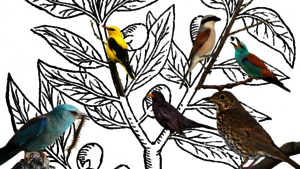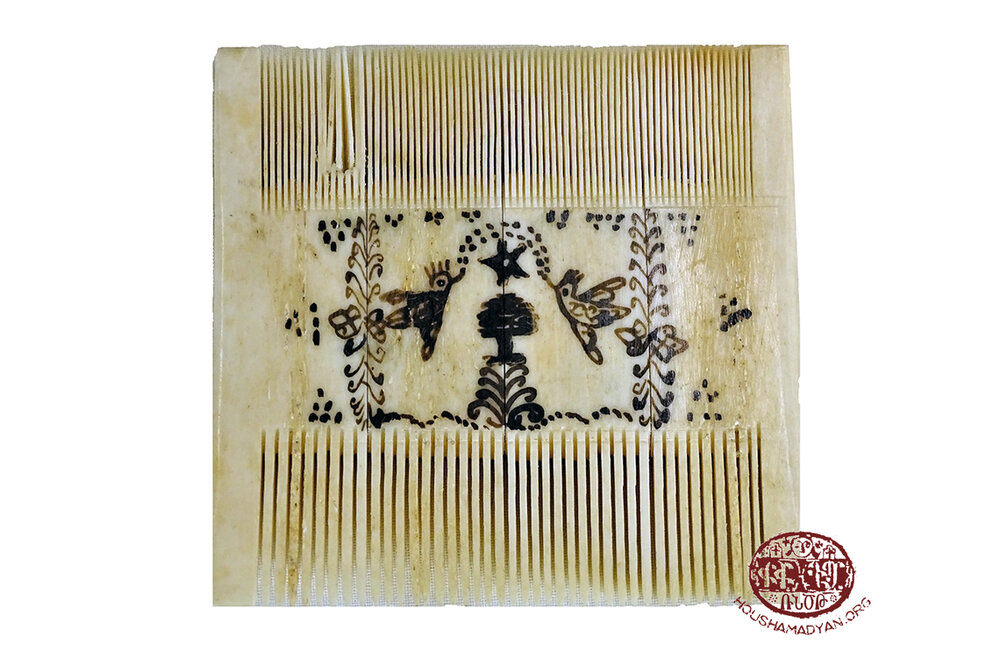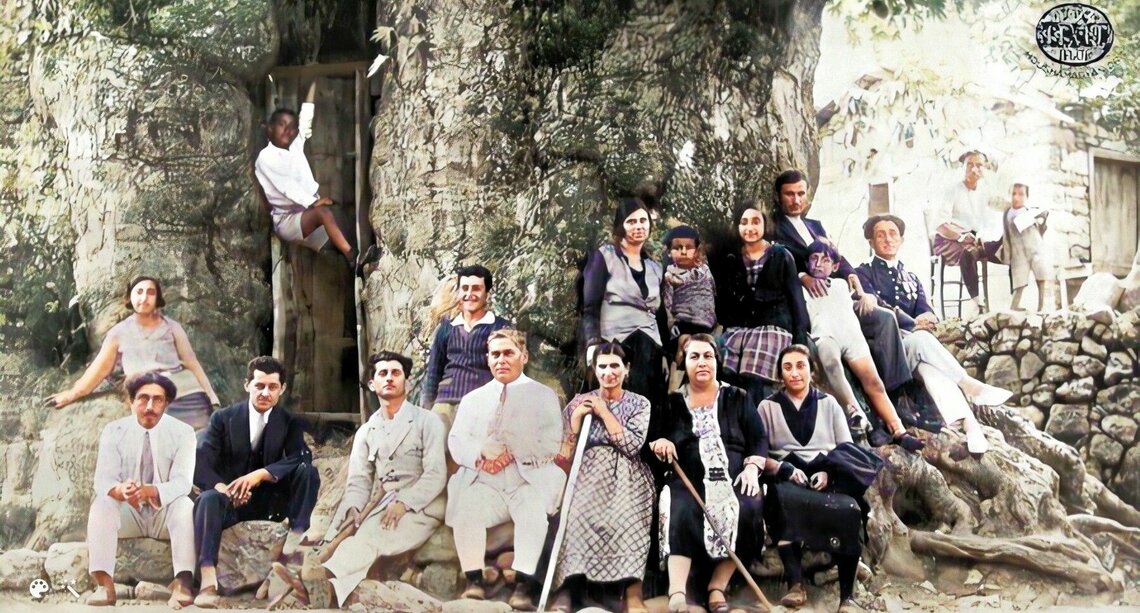Musa Dagh | Dialect | Trapping with Birdlime
Author: Hovig Atamian, 08/04/22 (Last modified 08/04/22) – Translator: Vahe Habeshian
This video is about the preparation of birdlime with sebestens—the plum-like fruit of the Assyrian plum (Cordia myxa, formerly Sebestena myxa)—in Musa Dagh.
In the dialect of Musa Dagh, the fruit is called dekhb (Arabic sibistān, Persian sapistān, Turkish sebesten).
Birdlime is a sticky, glue-like substance used to trap birds. In use since ancient times, it is produced worldwide from various plants by various methods, depending on geography.
In Musa Dagh, the birdlime is spread all over a thin branch or shoot, except for either end of the branch so that it can be held there when setting the trap. In the local dialect, that shoot or branch is called ur/ör.
That birdlime needs to dry on the branch for some five days, after which is placed among the branches of trees or bushes to trap birds. In Musa Dagh, when the wind blows from the north-northeast, the birdlime stops functioning; it loses its stickiness likely as a result of increased moisture in the air.
This method of trapping birds (i.e., with birdlime made of dekhb) is used in the northwest of Syria by Arabs as well as the Armenians of Kessab. This traditional form of bird trapping has also been maintained by Armenians who settled in Ainjar (Lebanon) from Musa Dagh.
The language spoken in the videos is the dialect of Musa Dagh.

Video | Musa Dagh | Trapping with Birdlime

Speech and Translation
Servin Chldrian (Madourian)
Servin Chldrian (Madourian) 17 February 2022, Ainjar (Lebanon).
Servin was born in 1930, in the Vakif village of Musa Dagh. She lived there until 1951, when she migrated, along with her family, to Beirut.
Musa Dagh Dialect | Armenian | English |
Տըպըխը պտէուղ մ'ի, սընծակի պէս խիւշիւր բէուն մ'ի | Տըպըխը պտուղ մըն է, սինձի պէս խոշոր բան մըն է: | The sebesten is a fruit, large as a hawthorn berry. |
Կ'առնայրըն բիրըննէն, կը հանայրըն զհայնտը, կը փռփեցնէին բերաննին քիջ մը, | Բերաննին կ՚առնէին, կը ծամէին, կը հանէին հունտը, կը փրփրեցնէին իրենց բերանին մէջ քիչ մը։ | They would place it into their mouths, remove the seed, froth it a bit in the mouth, |
Բիրաննին կը հանին տէյղ մը կը դնինզի | Բերանէն կը հանէին տեղ մը կը դնէին։ | Then remove it from the mouth and put it someplace, |
Կը դնին, այնտէյղ մէյնծ ամուն մը կու, անիր մէյջ կը դնէյնծի, | Կը դնեն, այնտեղ մեծ աման մը կայ, անոր մէջ կը դնեն։ | They place it-there's a large pot |
Ձիռու կը խառընկէյնծի, ատ խիւշիր սիխիրն ա հատէյր ին, կը բիրին, ղիյմա քեպապը պէս, կը բիրին կ'անցնեն զի վրան, ատ իղու տըպըխ: | Ձեռքով կը խառնեն, խոշոր սիխերն ալ պատրաստ են. կը բերեն, ղիյմա քեպապի պէս կ՚անցընեն վրան: Ահաւասիկ եղաւ տըպըխ: | They mix it by hand, and the long branches are ready; |
Առտու կանուխ հայր կ'ուրթուն, մէթ պըր ըննու տահա, պըր լարին, թռչուննէն դառ չարթնցուծ պըր լարէյնծի: | Առտու կանուխ երբ կ՚երթան, մութ պէտք է ըլլայ, պիտի լարեն: Նախքան թռչուններուն արթննալը պէտք է լարել: | When they go early in the morning—it must be dark—to set [the trap], they must set it when the birds aren't awake yet. |
Արթնան նէ կը փախին, չեն գար մարդ կը տեսնեն, կանուխ կ'ուրթուն կը լարէյնծի, իրենք կը պահուըտին, թռչունը՝ եկող թռչունը կը փակի: եկող թռչունը կը փակի: Աստուած ի՜մ: | Եթէ արթննան՝ կը փախչին, մարդ կը տեսնեն եւ չեն գար. [անոր համար] կանուխ կ՚երթան եւ կը լարեն, իրենք կը պահուըտին: Եկող թռչունը կը փակի, եկող թռչունը կը փակի... Աստուած իմ… | If the birds wake up, they flee—they see people, they don't come. So they'd go early to set it, they'd hide, then the bird—every bird that came along would get stuck—every bird that came along would get stuck... Oh my God! |

Vahe Chapar
Vahe Chapar, 3 September 2021, Vakif village, Musa Dagh.
Vahe's mother is from the Khidir Beg village; his father is from Yoghunoluk
Musa Dagh Dialect | Armenian | English |
Ըսսու տեխպինոյի, տեխպն ա ըսսէուն ի | Ա՛յս տեխպենի է, տեխպն ալ այս է: | This is the sebesten tree [Assyrian plum], and this is the sebesten. |
Թը կը կարիս մուտկըցընէյսզի, ըստէյղ պուլամատա կու | Եթէ կրնաս մօտեցնել [camera-ն], հոս շատ կայ: | If you can get [the camera] closer, there's a lot here. |
Տըխպը Ծօուռ օս ի | Տեխպի ծառը այս է: | This is the sebesten tree. |
Աս կը քաղընք | Այս կը քաղենք, | We harvest this, |
Մըրշէմ կը փռենյքզը արէյվ, իղլիլին սոնղ, | քիչ մը կը փռենք [տեխպը] արեւին տակ, հասուննալէն ետք, | and lay it out under the sun, after it ripens; |
եանի էուր մը արեյւ կը փռեյնքզի | այսինքն օր մը արեւին տակ կը փռենք, | so we lay it out under the sun for a day |
լէյղ թըղ զատւա ուրա միջին | որպէսզի պաղլեղը բաժնուի միջուկէն: | in order for the alum to separate from the pulp. |
սոնղ զաս, չուճըխնէն, կանճէյր, օնըր պըր շինէյզի | Յետոյ, փոքրերը, երիտասարդները, անոնք որոնք պիտի պատրաստեն, | Then, the children, young people, all those who will prepare it, |
հուտ-հուտ կ'առնին, մէյջ կը գլին, սոնղ լա՜կա՜նէն մէյջ կը թուքնոն զատ: | հատ-հատ կ՚առնեն, միջուկը կը հանեն, եւ ամանին մէջ կը թքեն [միջուկը]: | take them one by one, remove the pulp and spit it into the pot. |
դըրըզ թուքնիլ կը թուքնաունզի | Թքելու պէս կը թքեն [տեխպին միջուկը] | They spit it out as if it were saliva. |
կը ըրըքւայ մըրշեմ ադտէյղ, սոնղ միղր կը դնէն մէյջ: | Կը լեցուի քիչ մը այդտեղ, վերջը մեղր կը դնեն մէջը: | After it fills up a little in there, they add honey. |
չէուփ մը կունայ, ա՛ն չէուփ միղր կը դնեն, սոնղ աղվէյր մը կը խառընկէյնզի | Չափ մը ունի, ա՛յդ չափով մեղր կը դնեն, յետոյ, աղուոր մը կը խառնեն: | A certain amount of honey needs to go in; it's added, then mix it real well. |
Խառընկիլին սոնղ կը փըքքըրի ատ մըրշէյմ | Խառնելէն ետք քիչ մը կ՚ուռի, | After mixing, it expands a little. |
Սոնղ աուր, զատ աուր, կը փալլին. հէնտն ա իրվան կը կինու | Յետոյ, «ուռ»ը, այդ ուռը, կը թաթխեն [տեխպին մէջ]. հունտերն ալ [ուռին] վրան կը մնան: | Then, they dip the shoot/branch [in the birdlime]; the kernels also get on it. |
անիր սոնղ հայնտ կը զատին ըրմէյն | անկէ յետոյ հունտերը կը բաժնեն անկէ [ուռէն] | After that they separate the kernels [from the branch] |
դրզաս պըր ինէյսզի, անք էր քէյֆ կը ֆռացնէյզի. դըրըզ ագ, չէ կ'ասին էր, «հելեզօն», դըրըզ «հելեզօն» կ'ըննու եանի: | Այսպէս պիտի ընես, եւ ինք [ուռը] իր վրայէն կը թռցնէ [հունտերը]: Պարուրաձեւ կ՚ըլլայ այսինքն: | You have to do it in such a way that the branch casts off the kernels—like this. It becomes a spindle [it spirals], in other words. |
կ'իշիս նատուր իղու, ուրէն իրվան նատուր տէխպ կէու պիտանու քանզ ան կը շինիս, սոնղ կը չիրցնէյսզի, կը լա՜րէյսզի: | կը նայիս որքան եղաւ, ուռին վրայ որքան տեխպ պէտք է, այդ չափով կը շինես, յետոյ կը չորցնես, եւ կը լարես զայն: | You see how much is there—how much birdlime you need on the branch—you put that much on, then dry it and set the snare. |
եանի չիրնէօյլ... շարգը ֆըրթանուն, հանգ-վից ուր հիրաք ի, կը չիրցնէյզի | Այսինքն չորնալը... Արեւելքէն փչող հովը, հինգ-վեց օր հերիք է, կը չորցնէ զայն: | As for the drying… five or six days are enough for the wind blowing from the east to dry it. |
սոնղ կը լարէյսզի. Գրգըւուն պըր բռնիս, միղուըքուվ պըր բռնիս, սըմուն, թըսխարա պըր բռնիս, չայըր կ'էուզիս, եանի վախթէն կուրա, | Յետոյ, կը լարես զայն. կրնաս որսալ գրգուան, մեղուահաւ, կեռնեխ, թուխ սարեակ, ի՜նչ որ կ՚ուզես, այսինքն եղանակին համեմատ։ | Then, you set the snare. You can catch shrike, bee eater, song thrush, European blackbird, whatever you want—according to the season, in other words. |
կը սապինի ատ, պուրըյազէն չբռնիր | Հա, պուրըյազ [հով մը] որ ըլլայ, [տեխպը] օճառի պէս կ՚ըլլայ [կը թոյլնայ], | Sometimes it doesn't stick, what do they call that? |
պուրյուզ իղու, տէյխպ չբռնիր, դըրըզ սապին կ'ըննու, կը սիֆա: | Երբ պուրըյազ կայ, տեխպը չի բռներ, օճառի պէս կ՚ըլլայ, [որսը վրայէն] կը սահի: | If there's buriyaz, the birdlime doesn't stick, becomes like soap, [the prey] slides off. |

Hagop Khacher Hergelian
Hagop Khacher Hergelian, 26 February 2022, Ainjar (Lebanon). Hagop was born in Ainjar in 1944. He's a farmer. His parents are from the Khidir Beg village of Musa Dagh.
Musa Dagh Dialect | Armenian | English |
Ըմմը ամմըն ձգ դավըր մը ագ կ'ունայ, ագ, օրէնք: | Բայց ամէն թռչուն իր որսալու օրէնքը ունի: | But there is a trapping rule for every type of bird. |
Միղվըքէուվ մութըրըզէն իրվան ըրկը ճղա կը դնայրընք դըսսու չաթալա, տէյխպ կը դնիս իրվան, կ'իլվա քարմանվա միղրըքէուվ, պազ միղվըքէով մը բռնուայի մըկ տխպէն, ալայր կ'իջնեն հուն գալան: Ան ձան կը հանի, չուց համու մաքինէ ձան կու հանի, անչաք մաքինա չունայրընք | Մեղուահաւը օրինակ, թրաքթորով հերկուած տեղ մը, գուղձերուն վրայ երկու ճիւղիկ կը դնէինք, անոնց վրայ ալ տեխպ կը դնէինք: Մեղուահաւը կը թռչէր, կը դառնար, եւ եթէ մէկ մեղուահաւ բռնուէր տեխպին վրայ, բոլորը կը սկսէին իջնել հոն: Անիկա [բռնուող մեղուահաւը] ձայն կը հանէ, ինչպէս որ հիմա գործիքները ձայն կը հանեն. այն ատեն գործիք չունէինք: | The bee eater, for example: in area plowed by a tractor, we would place two Y-shaped sticks into the cods of dirt, and place the birdlime branch across them. Bee eaters would fly around and, if one got caught on the birdlime, all of them would start to land. It [the first one caught] would make a sound, just as now there are bird-calling devices do; back then we didn't have those. |
Մէ միղվըքէուվ անք զէր ընկըրվէուն կը կինչի: Ըրկը մըկ ըրք մըկ կը կախվա ամըն տխպէ իրվան: Թրզատ գիտայն: | [Բռնուած] մէկ մեղուահաւը իր ընկերները կը կանչէ: Երկու-երեք հատ կը կախուի ամէն մէկ տեխպին վրայ: Այսպէ՛ս, գետինը: | The [captured] bee eater would call out to its friends. Two or three would get caught on the birdlime, there on the ground. |
Շռախվօուր, ծօուռ կու բռնուայ: Ան շռախվօրէն ագն ա բունձր ծօուռ պըր դնես, կու գու ծօուռ կու նստայ: | Ներկարար/շրախվարը ծառին վրայ կը բռնուի: Այդ շրախվարին տեխպն ալ բարձր ծառին վրայ պիտի դնես. կու գայ, ծառին վրայ կը նստի: | The European roller is trapped in trees. You have to place the birdlime for catching that roller high up in a tree; it comes and sits in the tree. |
Իժկըտվիցու թէյվ դըսսու, թիվէն զօուրք բռնից, խալիսիցու գալան, անք չու կարի, կը կախվայ: | Շարժեցա՞ւ թեւը այսպէս, թեւին ծայրը բռնուեցա՞ւ. վերջացաւ այլեւս. չի կրնար [փախչիլ], կը կախուի: | It moves around? Its tip of its wing touches the birdlime? It's done for; it can't [escape], it's left dangling. |
Պըլպայլ. պլպուլէն ագ կաննըմակ կը դնին զտայպ, պըր ուգու սըֆթա անտէյղ նստայ, սօնկ պըր իջնա ի ծօուռ: | Ոսկեսարեակը. ոսկեսարեակին տեխպը կայնած կը դնեն: Պիտի գայ, նախ հոն նստի, յետոյ իջնէ դէպի ծառը: | The Eurasian golden oriole: The birdlime branch is placed vertically. It'll come to first perch there, before going down into the tree. |
Պըլպայլ, գրգըվօուն, կակօուչ. կակօուչ ջրէն զօրք կը նստայ, ջրէն զօրք պըր դնիս ճղէմ դըսսու, կը սֆթայ, հուն կը նստայ, սոնղ կ'իջնայ ի վար: հուն կը բռնուայ զաթըն: | Ոսկեսարեակը, գրգուանը, քարաբնակը. քարաբնակը ջրեզերքը կը նստի: Ջրեզերքը պիտի դնես ճիւղիկ մը այսպէս, նախ կը նստի, յետոյ կ'իջնէ դէպի վար: Հոն կը բռնուի արդէն: | The goldern oriole, the shrike, the wheater: the wheater lands on the edge of water; you place the small branch [with birdlime] at water's edge; it'll first perch there, before going on to land. It'll already be caught. |
Անինց տայխպ, տըքէ զօրք կ'ըննու, ճղէն: Միկալ տայխպ, զիրքին մրշէմ պակուս պըր ըննու, ուրա ճղէն իրվան հար կը դնիս չփակայ ի ճէուղ: | Անոնց համար պատրաստուած տեխպը մինչեւ ծայր կ'ըլլայ: Միւսներունը, «ուռ»ին ծայրէն քիչ մը վար պէտք է քսուած ըլլայ, որպէսզի երբ «ուռ»ը ծառին ճիւղին վրայ դնես, չփակի ճիւղին: | The branch prepared for those is applied with birdlime all the way to the tip. For the others, it should be applied a little lower so that when you place it on a tree branch it doesn't stick to the branch. |

Bone comb made in 1948 in Tripoli, Lebanon by Kapriel/Jabra Shemmassian (from Musa Dagh) as a gift to Jamilé Sherbetjian Stambulian, sister of Kapriel’s wife, Marta (Source: Courtesy of Jamilé Sherbetjian Stambulian. Vahram Shemmassian collection, Los Angeles).
